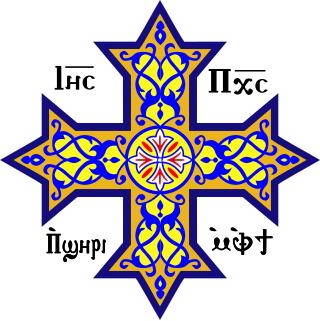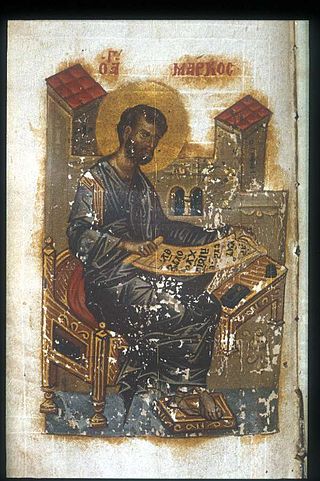
The Codex Vaticanus, designated by siglum B or 03, δ 1, is a fourth-century Christian manuscript of a Greek Bible, containing the majority of the Greek Old Testament and the majority of the Greek New Testament. It is one of the four great uncial codices. Along with Codex Alexandrinus and Codex Sinaiticus, it is one of the earliest and most complete manuscripts of the Bible. The codex has been dated palaeographically to the 4th century.
In textual criticism of the New Testament, the Western text-type is one of the main text types. It is the predominant form of the New Testament text witnessed in the Old Latin and Syriac Peshitta translations from the Greek, and also in quotations from certain 2nd and 3rd-century Christian writers, including Cyprian, Tertullian and Irenaeus. The Western text had many characteristic features, which appeared in text of the Gospels, Book of Acts, and in Pauline epistles. The Catholic epistles and the Book of Revelation probably did not have a Western form of text. It was named "Western" by Semmler (1725–1791), having originated in early centers of Christianity in the Western Roman Empire.

The Codex Alexandrinus, designated by the siglum A or 02, δ 4, is a manuscript of the Greek Bible, written on parchment. Using the study of comparative writing styles (palaeography), it has been dated to the fifth century. It contains the majority of the Greek Old Testament and the Greek New Testament. It is one of the four Great uncial codices. Along with Codex Sinaiticus and Vaticanus, it is one of the earliest and most complete manuscripts of the Bible.

There have been many Coptic versions of the Bible, including some of the earliest translations into any language. Several different versions were made in the ancient world, with different editions of the Old and New Testament in five of the dialects of Coptic: Bohairic (northern), Fayyumic, Sahidic (southern), Akhmimic and Mesokemic (middle). Biblical books were translated from the Alexandrian Greek version.

The Curetonian Gospels, designated by the siglum syrcur, are contained in a manuscript of the four gospels of the New Testament in Old Syriac. Together with the Sinaiticus Palimpsest the Curetonian Gospels form the Old Syriac Version, and are known as the Evangelion Dampharshe in the Syriac Orthodox Church.

Codex Nitriensis, designated by R or 027, ε 22, is a 6th-century Greek New Testament codex containing the Gospel of Luke, in a fragmentary condition. It is a two column manuscript in majuscules, measuring 29.5 cm by 23.5 cm.
Uncial 068, ε 3 (Soden), is a Greek uncial manuscript of the New Testament, dated paleographically to the 5th century. Tischendorf designated it by Ib, Scrivener by Nb. It has some marginalia.

Minuscule 33, δ 48 (Soden), before the French Revolution was called Codex Colbertinus 2844. It is a Greek minuscule manuscript of the New Testament on parchment, dated palaeographically to the 9th century. The manuscript is lacunose. It has marginalia. According to the textual critics it is one of the best minuscule manuscripts of the New Testament.

Syriac is a dialect of Aramaic. Portions of the Old Testament were written in Aramaic and there are Aramaic phrases in the New Testament. Syriac translations of the New Testament were among the first and date from the 2nd century. The whole Bible was translated by the 5th century. Besides Syriac, there are Bible translations into other Aramaic dialects.
Minuscule 892, ε 1016 (Soden). It is a Greek minuscule manuscript of the New Testament, on 353 parchment leaves. It is dated palaeografically to the 9th century.

Minuscule 46, ε 1285, is a Greek minuscule manuscript of the New Testament, on parchment leaves. Paleographically it has been assigned to the 13th century. It has complex contents and full marginalia.
Minuscule 67, ε 150, known as Codex Galei Londinensis, is a Greek minuscule manuscript of the New Testament, on parchment leaves. Palaeographically it has been assigned to the 10th century. The manuscript is lacunose. Some leaves of the codex were lost. It has full marginalia.
Lectionary 2145 designated by siglum ℓ2145, is a Greek minuscule manuscript of the New Testament, written on 2 parchment leaves. Paleographically it has been assigned to the 13th century.
Codex Phillipps 1388, Syriac manuscript of the New Testament, on parchment. It contains the text of the four Gospels. Palaeographically it had been assigned to the 5th/6th centuries. It is one of the oldest manuscripts of Peshitta with some Old Syriac readings.
The Crawford Aramaic New Testament manuscript is a 12th-century Aramaic manuscript containing 27 books of the New Testament. This manuscript is notable because its final book, the Book of Revelation, is the sole surviving manuscript of any Aramaic version of the otherwise missing Book of Revelation from the Peshitta Syriac New Testament. Five books were translated into Syriac later for the Harklean New Testament.
Codex Sinaiticus Rescriptus, mostly originating in Saint Catherine's Monastery, Sinai, is an accumulation of sixteen or even eighteen Christian Palestinian Aramaic palimpsest manuscripts containing Old Testament, Gospel and Epistles pericopes of diverse Lectionaries, various unidentified homilies and one by John Chrysostom, hagiographic texts as the Life of Pachomios, the Martyrdom of Philemon Martyrs, and the Catecheses by Cyril of Jerusalem. The manuscripts are recycled parchment material that were erased and reused by the tenth century Georgian scribe Ioane-Zosime for overwriting them with homilies and a Iadgari. Part of the parchment leaves had been brought by him from the Monastery of Saint Sabas, south of Jerusalem, when he moved to St Catherine's Monastery and became there librarian. In the nineteenth century most of the codex was removed from the monastery at two periods. C. Tischendorf took two thirds in 1855 and 1857 with the Codex Sinaiticus to St Peterburg and handed it over to the Imperial Library, now the National Library of Russia, and the remaining third left on a clandestine route and found its way into various European and later also into US collections, at present in a Norwegian collection. From the New Finds of 1975 in the Monastery of Saint Catherine missing folios of some of the underlying manuscripts could be retrieved.







